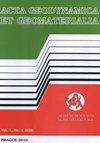Geoid undulation prediction using Gaussian Processes Regression: A case study in a local region in Turkey
IF 0.8
4区 地球科学
Q4 GEOCHEMISTRY & GEOPHYSICS
引用次数: 2
Abstract
In order to convert ellipsoidal heights obtained by the Global Navigation Satellite System (GNSS) to orthometric heights, it is necessary to know the distance between the ellipsoidal and geoid surface, called the geoid undulation. The geoid undulation can be predicted using emerging mathematics tools and algorithms. The objective of this study was to develop a model for predicting the geoid undulation using Gaussian Process Regression (GPR), one of the soft machine learning algorithms having different covariance functions. This method was then compared with the radial basis function neural network (RBFNN), generalized regression neural network (GRNN), and the interpolation method of inverse distance to a power (IDP) with the power of 1, 2, 3, 4, and 5. First, 70 % of GNSS/leveling data (422 points) were used in the training phase. The remaining 185 points were used as testing data to check the effectiveness of the constructed model. In the GPR modeling, ten covariance functions (Materniso d= 1, 3, 5; Maternard d= 1, 3, 5; SEiso; SEard; RQiso; and RQard) were tested for prediction on this dataset. The GPR based on the Materniso (d = 1) covariance function model was introduced as an effective method for predicting geoid undulation and provided the best results (RMSE = 8.32 cm, MAE = 5.51 cm, R2 = 0.98968) when compared with the other developed GPR models. In addition, the statistical findings showed that the accuracy of all the GPR models was also better in predicting geoid undulation than the RBFNN, GRNN, and IDP with the power of 1, 2, 3, 4, and 5. ARTICLE INFO利用高斯过程回归预测大地水准面波动:土耳其局部地区的案例研究
为了将全球导航卫星系统(GNSS)获得的椭球面高度转换为正等高,需要知道椭球面与大地水准面之间的距离,称为大地水准面波动。大地水准面起伏可以用新兴的数学工具和算法来预测。本研究的目的是建立一个利用高斯过程回归(GPR)预测大地水准面波动的模型,高斯过程回归是一种具有不同协方差函数的软机器学习算法。将该方法与径向基函数神经网络(RBFNN)、广义回归神经网络(GRNN)以及1、2、3、4、5次幂的距离逆幂插值方法(IDP)进行比较。首先,在训练阶段使用了70%的GNSS/水准数据(422个点)。剩余的185个点作为检验数据,检验所构建模型的有效性。在GPR建模中,10个协方差函数(Materniso d= 1,3,5;母亲d= 1,3,5;清洁;SEard;RQiso;和RQard)在该数据集上进行了预测测试。采用Materniso (d = 1)协方差函数模型预测大地水准面波动是一种有效的方法,与已有的GPR模型相比,RMSE = 8.32 cm, MAE = 5.51 cm, R2 = 0.98968。此外,统计结果表明,所有GPR模型在预测大地水准面波动方面的精度也优于RBFNN、GRNN和IDP(1、2、3、4、5次幂)。条信息
本文章由计算机程序翻译,如有差异,请以英文原文为准。
求助全文
约1分钟内获得全文
求助全文
来源期刊

Acta Geodynamica et Geomaterialia
地学-地球化学与地球物理
CiteScore
2.30
自引率
0.00%
发文量
12
期刊介绍:
Acta geodynamica et geomaterialia (AGG) has been published by the Institute of Rock Structures and Mechanics, Czech Academy of Sciences since 2004, formerly known as Acta Montana published from the beginning of sixties till 2003. Approximately 40 articles per year in four issues are published, covering observations related to central Europe and new theoretical developments and interpretations in these disciplines. It is possible to publish occasionally research articles from other regions of the world, only if they present substantial advance in methodological or theoretical development with worldwide impact. The Board of Editors is international in representation.
 求助内容:
求助内容: 应助结果提醒方式:
应助结果提醒方式:


